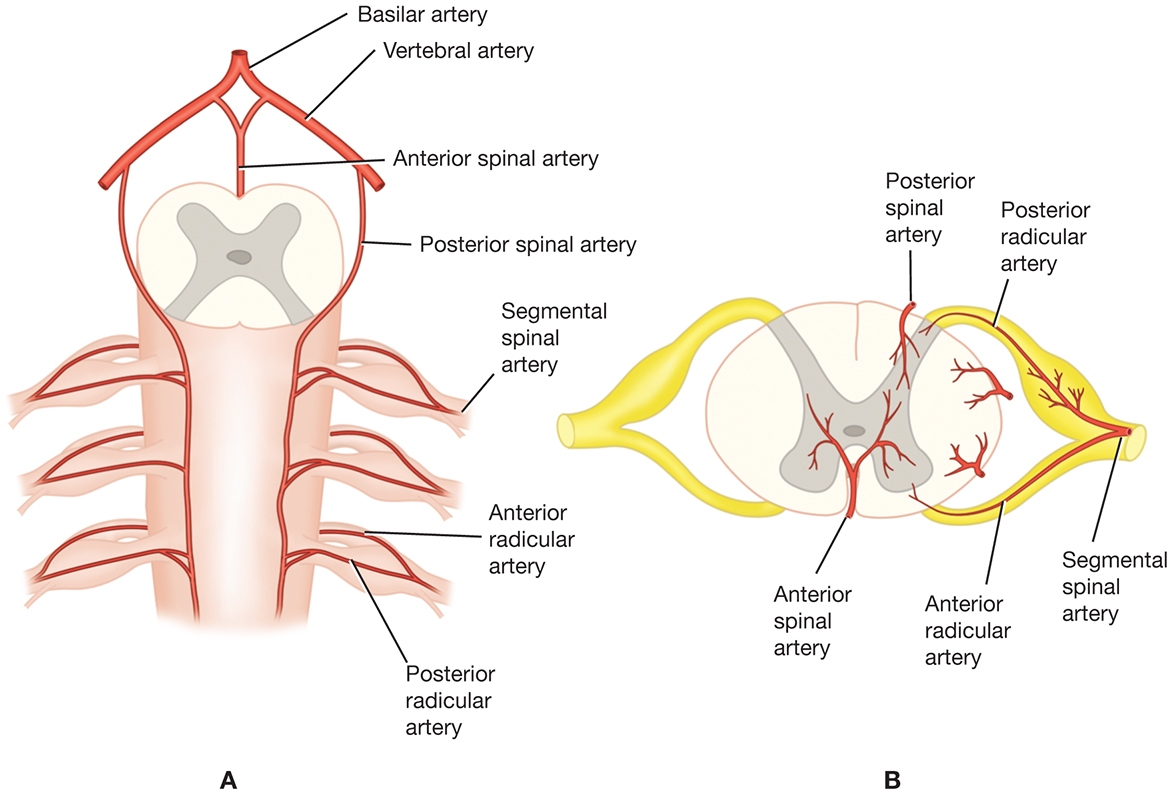B.5. What is the spinal cord blood supply?
Answer:
The spinal cord blood supply consists of both longitudinal and segmental components (Figure 9.9). The longitudinal arteries include the anterior and paired posterior spinal arteries. The anterior spinal artery (ASA) arises from paired feeding vessels that originate in the vertebral arteries near the foramen magnum. It extends the length of the spinal cord and is situated in the anterior spinal sulcus. The ASA is fed by a series of radicular arteries, and the areas between these radicular contributions are watershed areas that are at the greatest risk of ischemia. The most significant of these radicular arteries is the artery of Adamkiewicz. It is a large radicular contribution that most commonly arises between T8 and L2, although it can originate as high as T5 and as low as L4. The artery of Adamkiewicz is critical to the maintenance of adequate collateral blood supply to the lower two-thirds of the spinal cord. The ASA supplies the anterior two-thirds of the spinal cord, including the corticospinal and spinothalamic tracts, and is dependent on a robust collateral circulation, making it particularly susceptible to ischemic injury.
Figure 9.9.: Spinal Cord Blood Supply.

Spinal cord blood supply. A. Longitudinal spinal cord blood supply. B. Spinal and radiculary artery distributions. (Reprinted with permission from Splittgerber R. Blood supply of the brain and spinal cord. In: Snell's Clinical Neuroanatomy. 8th ed. Wolters Kluwer; 2018:471.)
There are two paired posterior spinal arteries that originate as branches of either the vertebral or posterior inferior cerebellar arteries and descend along the posterolateral portion of the spinal cord. The posterior spinal arteries are also fed by numerous radicular arteries. The anterior and posterior spinal arteries are connected to each other via a circular anastomosis known as the vasocorona medullaris.
In addition to the longitudinal arteries, there are multiple segmental branches that arise from the posterior portion of the aorta. These include the intercostal, subcostal, and lumbar segmental arteries. These arteries travel posteriorly and branch to supply the vertebral bodies, muscle and cutaneous structures, and spinal cord. The spinal division enters through the intervertebral foramen and subdivides to supply either the vertebral and ligamentous structures or the nerve roots and dura. At some levels, the arteries supplying the nerve roots and dura also supply the spinal cord. These vessels are termed radiculomedullary arteries and play an important role in supplying accessory flow to both the anterior and posterior spinal arteries.
References
- Santillan A, Nacarino V, Greenberg E, et al. Vascular anatomy of the spinal cord. J Neurointerv Surg. 2012;4:67-74.
- Ullery BW, Wang GJ, Low D, et al. Neurological complications of thoracic endovascular aortic repair. Semin Cardiothorac Vasc Anesth. 2011;15:123-140.


